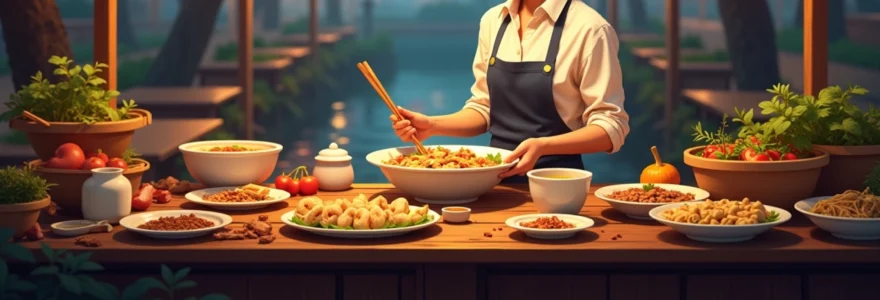Vietnamese cuisine stands as a testament to the country’s rich history, diverse geography, and vibrant culture. From the bustling street food scenes of Hanoi and Ho Chi Minh City to the intimate family kitchens nestled in rural villages, Vietnamese food tells a story of resilience, innovation, and an unwavering commitment to flavour. This culinary landscape is not just about sustenance; it’s a reflection of Vietnam’s soul, where every dish carries the weight of tradition and the promise of modernity.
Evolution of vietnamese cuisine: from imperial courts to modern fusion
The journey of Vietnamese cuisine is as complex and layered as the flavours that define it. Rooted in ancient traditions, the country’s culinary practices have been shaped by centuries of imperial rule, foreign influences, and regional diversity. The royal kitchens of the Nguyen Dynasty in Hue once prepared elaborate feasts that showcased the pinnacle of Vietnamese gastronomy, setting standards that would influence cooking throughout the nation.
As Vietnam transitioned through periods of colonisation and war, its cuisine adapted and evolved. The French colonial era introduced new ingredients and techniques, forever changing the landscape of Vietnamese cooking. Baguettes became the foundation for bánh mì , while French coffee culture gave rise to Vietnam’s beloved cà phê sữa đá (iced coffee with condensed milk).
In recent years, Vietnamese cuisine has embraced globalisation while fiercely protecting its core identity. Chefs in urban centres like Ho Chi Minh City are experimenting with molecular gastronomy and fusion concepts, reimagining classic dishes for a new generation of diners. Yet, the essence of Vietnamese cooking—its balance of flavours, emphasis on fresh ingredients, and respect for tradition—remains steadfast.
Regional culinary traditions: north, central, and south vietnam
Vietnam’s geography, stretching over 1,600 kilometres from north to south, has given rise to distinct regional cuisines, each with its own flavour profile and specialities. The country’s culinary map is typically divided into three main regions, each offering a unique gastronomic experience.
Hanoi’s phở and bún chả: northern staples
Northern Vietnamese cuisine, centred around Hanoi, is known for its subtle flavours and the use of herbs and fresh ingredients. The cooler climate influences both the ingredients available and the cooking methods employed. Phở , the iconic Vietnamese noodle soup, originated in the north and is typically served with a clearer broth and fewer garnishes than its southern counterpart.
Bún chả , another Hanoi speciality, consists of grilled pork served with rice noodles and a fragrant dipping sauce. This dish exemplifies the northern preference for balanced flavours and simple presentation. The streets of Hanoi’s Old Quarter come alive with the aroma of sizzling meat and the chatter of locals enjoying these beloved dishes at modest street-side stalls.
Huế’s imperial cuisine: central vietnam’s royal heritage
Central Vietnamese cuisine, particularly that of Hue, the former imperial capital, is characterised by its complexity and historical significance. The legacy of royal banquets is evident in the intricate presentation and bold flavours of Hue’s specialities. Bún bò Huế , a spicy beef noodle soup, and bánh bèo , delicate steamed rice cakes topped with shrimp, are just two examples of the region’s culinary prowess.
The central region’s cuisine also reflects its geography, with an abundance of seafood dishes and the use of chilli to combat the humid climate. The flavours here are often described as spicier and more robust than those found in the north or south.
Saigon’s cơm tấm and bánh mì: southern street food icons
Southern Vietnamese cuisine, with Ho Chi Minh City (formerly Saigon) as its epicentre, is known for its sweetness and the liberal use of herbs and fresh vegetables. The region’s fertile Mekong Delta provides a bounty of fresh produce, tropical fruits, and seafood, influencing the local diet and culinary traditions.
Cơm tấm , or broken rice, is a quintessential southern dish often served with grilled pork, pickled vegetables, and a sunny-side-up egg. It’s a staple of Saigon’s street food scene, enjoyed by locals and visitors alike. Bánh mì , while found throughout Vietnam, reaches its zenith in the south, where vendors stuff crusty baguettes with a variety of fillings, creating a perfect fusion of Vietnamese and French culinary traditions.
Mekong delta’s floating markets: culinary diversity of the south
The Mekong Delta region, often referred to as Vietnam’s ‘rice bowl’, offers a unique culinary landscape shaped by its abundant waterways and fertile soil. Floating markets, such as those in Cai Rang and Can Tho, showcase the region’s agricultural wealth and culinary diversity. Here, boats laden with fresh produce, aromatic herbs, and local delicacies create a vibrant tapestry of colours and flavours.
Dishes like cá lóc nướng trui (grilled snakehead fish) and bánh xèo (crispy rice pancakes) are staples of the delta’s cuisine, reflecting the region’s abundance of fish and rice. The Mekong Delta’s culinary traditions also incorporate influences from neighbouring Cambodia and the local Khmer population, adding another layer of complexity to southern Vietnamese cuisine.
Street food culture: vietnam’s gastronomic heartbeat
Street food is the lifeblood of Vietnamese cuisine, offering a window into the country’s culinary soul. From bustling city streets to quiet alleyways, the aroma of sizzling meats, fragrant herbs, and bubbling broths permeates the air, inviting locals and tourists alike to partake in this essential aspect of Vietnamese culture.
Anatomy of a vietnamese street food stall
A typical Vietnamese street food stall is a marvel of efficiency and simplicity. Often no more than a small cart or a collection of low plastic stools clustered around a makeshift kitchen, these stalls are the backbone of Vietnam’s culinary scene. Key elements include:
- A portable stove or grill for cooking fresh ingredients
- Stacks of bowls, plates, and utensils for serving
- An array of condiments and garnishes for customisation
- A dedicated prep area for assembling dishes quickly
The success of these stalls lies in their specialisation, with many vendors focusing on perfecting a single dish over generations. This dedication to craft results in unparalleled flavour and quality, often surpassing that found in more formal dining establishments.
Hanoi’s old quarter: A street food mecca
Hanoi’s Old Quarter is a labyrinth of narrow streets and alleyways, each offering a unique culinary experience. Here, the tradition of street food is deeply ingrained in daily life. Locals start their day with a steaming bowl of phở or a plate of bánh cuốn (steamed rice rolls), often eating quickly while perched on tiny plastic stools.
As the day progresses, the streets come alive with vendors selling everything from bánh mì to bún chả . The Old Quarter is particularly famous for its bia hơi corners, where locals gather in the evening to enjoy fresh draught beer and simple snacks, creating a convivial atmosphere that epitomises Hanoi’s street food culture.
Saigon’s vạn kiếp street: nighttime culinary adventure
In Ho Chi Minh City, Vạn Kiếp Street in District 3 transforms into a bustling food haven as night falls. This street exemplifies the southern approach to street food, with a wider variety of dishes and a more relaxed dining atmosphere. Visitors can sample bột chiên (fried rice flour cakes), ốc (snails cooked in various styles), and cơm tấm all within a few metres of each other.
The street food scene in Saigon is characterised by its diversity and fusion of flavours, reflecting the city’s history as a melting pot of cultures. Here, Chinese, Khmer, and French influences mingle with traditional Vietnamese cooking, creating a unique culinary landscape that continues to evolve.
Street food safety: navigating hygiene and quality
While street food is an integral part of Vietnamese cuisine, concerns about food safety and hygiene are valid. To enjoy street food safely, consider the following tips:
- Observe the vendor’s cleanliness and food handling practices
- Choose busy stalls with high turnover for fresher ingredients
- Opt for cooked foods served piping hot
- Bring your own chopsticks or utensils if you’re particularly concerned
Many street food vendors take pride in their cleanliness and the quality of their ingredients. By exercising caution and following local recommendations, visitors can safely enjoy the vibrant street food culture that is so central to Vietnamese cuisine.
Family kitchens: the soul of vietnamese cooking
While street food captures the public face of Vietnamese cuisine, the true heart of the country’s culinary traditions lies in its family kitchens. Here, recipes passed down through generations are lovingly prepared, and the art of Vietnamese cooking is preserved and nurtured.
Intergenerational recipes: preserving culinary heritage
In Vietnamese culture, food is a powerful connection to family history and identity. Recipes are often passed down orally from mother to daughter, with each generation adding its own subtle variations while maintaining the essence of the dish. These family recipes are treasured heirlooms, carrying with them stories of ancestors, historical events, and cultural significance.
Many Vietnamese dishes require complex preparation techniques and a deep understanding of ingredient combinations. The process of learning these recipes becomes a form of bonding between generations, ensuring that traditional cooking methods and flavours are not lost to time. For example, the preparation of bánh chưng , a special rice cake made for Tết (Lunar New Year), often involves the entire family and serves as a way to pass on cultural knowledge and values.
Lunar new year (tết) feasts: family traditions and symbolism
Tết, the Vietnamese Lunar New Year, is the most important holiday in the country, and food plays a central role in the celebrations. Family kitchens become hubs of activity as elaborate feasts are prepared, each dish carrying symbolic meaning for the coming year. Some essential Tết dishes include:
- Bánh chưng and bánh tét : Sticky rice cakes symbolising earth and sky
- Thịt kho tàu : Caramelised pork and eggs representing prosperity
- Xôi gấc : Red sticky rice for good luck and happiness
- Mứt Tết : Candied fruits and vegetables for sweetness in the new year
The preparation and sharing of these dishes reinforce family bonds and cultural identity, with each region and family adding their own unique touches to the traditional Tết menu.
Modern vietnamese home cooking: adapting traditional techniques
As Vietnam modernises, family kitchens are adapting to changing lifestyles and ingredients. Urban families, faced with time constraints and smaller living spaces, are finding innovative ways to preserve traditional flavours while incorporating modern cooking techniques and appliances.
This evolution has led to a new wave of Vietnamese home cooking that balances convenience with tradition. Pressure cookers might be used to speed up the preparation of phở broth, while air fryers offer a healthier alternative for making crispy chả giò (spring rolls). Despite these adaptations, the essence of Vietnamese home cooking—its focus on fresh ingredients, balanced flavours, and familial connection—remains intact.
Key ingredients and techniques in vietnamese cuisine
At the core of Vietnamese cuisine lies a set of fundamental ingredients and cooking techniques that define its unique flavour profile and culinary philosophy. Understanding these elements is key to appreciating the depth and complexity of Vietnamese dishes.
Fish sauce (nước mắm): the quintessential vietnamese flavour
Nước mắm , or fish sauce, is the cornerstone of Vietnamese cuisine. This pungent, amber-coloured liquid is made from fermented fish and salt, providing a deep umami flavour to dishes. Its importance in Vietnamese cooking cannot be overstated; it’s used as a seasoning, a dipping sauce base, and a marinade.
The quality of nước mắm can vary greatly, with the finest varieties produced on the island of Phú Quốc. These premium fish sauces are aged in wooden barrels, resulting in a complex flavour profile that is both salty and slightly sweet. The use of nước mắm is so ingrained in Vietnamese cuisine that its aroma is often described as the ‘smell of home’ for many Vietnamese people.
Rice and noodle varieties: from bánh phở to bún
Rice is the staple grain of Vietnam, forming the foundation of most meals. Beyond steamed rice, a variety of rice-based products play crucial roles in Vietnamese cuisine:
- Bánh phở : Flat rice noodles used in the eponymous soup
- Bún : Thin vermicelli rice noodles
- Bánh tráng : Rice paper used for spring rolls
- Gạo nếp : Glutinous rice for sweet and savoury dishes
Each type of rice product has specific applications in Vietnamese cooking, contributing to the diverse textures and flavours found across different dishes. The versatility of rice in Vietnamese cuisine reflects the country’s agricultural heritage and the ingenuity of its cooks in creating a wide array of dishes from a single ingredient.
Herbs and aromatics: balancing flavours in vietnamese dishes
Fresh herbs and aromatics are essential to Vietnamese cuisine, providing not just flavour but also nutritional and medicinal benefits. Common herbs include:
- Rau răm (Vietnamese coriander)
- Húng quế (Thai basil)
- Ngò gai (Culantro)
- Tía tô (Perilla)
- Mint and cilantro
These herbs are not mere garnishes but integral components of dishes, often used in generous quantities. They provide freshness, aroma, and complexity to Vietnamese cuisine, balancing out richer flavours and adding layers of taste and texture.
Fermentation and pickling: traditional preservation methods
Fermentation and pickling techniques have long been used in Vietnamese cuisine to preserve foods and create unique flavours. These methods not only extend the shelf life of ingredients but also contribute to the complex taste profiles characteristic of many Vietnamese dishes.
Dưa chua (pickled vegetables) are a common accompaniment to meals, providing a crunchy, tangy contrast to rich dishes. Fermented fish and shrimp pastes, such as mắm tôm and mắm nêm , are used as flavour enhancers in various recipes,
adding depth and complexity to many Vietnamese dishes.
Fermented sauces and pastes are often used sparingly but pack a powerful punch of flavor. They exemplify the Vietnamese culinary philosophy of balancing strong tastes with fresh ingredients to create harmonious dishes.
Global influence and modern innovations in vietnamese cuisine
Vietnamese cuisine, while deeply rooted in tradition, has also been shaped by global influences and continues to evolve in the modern era. This dynamic interplay between tradition and innovation has led to exciting developments in the culinary landscape of Vietnam.
French colonial legacy in vietnamese cooking
The French colonial period left an indelible mark on Vietnamese cuisine, introducing new ingredients, techniques, and dishes that have since been adapted and integrated into the local culinary repertoire. Some notable examples include:
- Bánh mì: The iconic Vietnamese sandwich that combines a French baguette with local fillings
- Phở: While its origins are debated, some argue that the beef broth was influenced by French pot-au-feu
- Cà phê sữa đá: Vietnamese iced coffee with condensed milk, a legacy of French coffee culture
These culinary fusions demonstrate the Vietnamese ability to adapt foreign influences while maintaining a distinct cultural identity. The French influence also introduced new cooking techniques and a appreciation for dairy products, previously uncommon in Vietnamese cuisine.
Vietnamese-american fusion: the evolution of phở and bánh mì
The Vietnamese diaspora, particularly in the United States, has led to the creation of unique fusion cuisines that blend traditional Vietnamese flavors with American ingredients and tastes. This cultural exchange has resulted in innovative dishes such as:
- Phở burrito: A San Francisco creation that wraps phở ingredients in a burrito format
- Bánh mì pizza: Combining the flavors of bánh mì with the form of pizza
- Phở-flavored ice cream: A dessert that captures the essence of the famous soup
These fusion creations not only cater to the tastes of second and third-generation Vietnamese-Americans but also introduce Vietnamese flavors to a broader audience. As these dishes gain popularity, they sometimes find their way back to Vietnam, influencing the culinary scene in major cities.
Fine dining and molecular gastronomy: reimagining vietnamese classics
In recent years, a new generation of Vietnamese chefs has begun to apply modern culinary techniques and presentation styles to traditional dishes, elevating Vietnamese cuisine to new heights. This movement is particularly evident in upscale restaurants in Ho Chi Minh City and Hanoi, where chefs are experimenting with:
- Deconstructed phở: Presenting the components of the classic soup in innovative ways
- Molecular gastronomy techniques applied to Vietnamese ingredients
- Tasting menus that showcase regional specialties with a modern twist
These chefs are not only reimagining Vietnamese cuisine for a high-end audience but also preserving traditional flavors and techniques by presenting them in new, exciting ways. This evolution of Vietnamese cuisine demonstrates its adaptability and enduring relevance in the global culinary landscape.
As Vietnamese cuisine continues to gain international recognition, it remains rooted in its core principles of fresh ingredients, balanced flavors, and cultural significance. From street food stalls to family kitchens to innovative fine dining establishments, the journey of Vietnamese food reflects the country’s rich history and promising future. Whether enjoyed on a plastic stool on a busy Hanoi street or in a sleek restaurant in Ho Chi Minh City, Vietnamese cuisine continues to captivate and inspire food lovers around the world.


